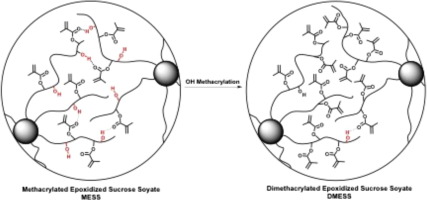当前位置:
X-MOL 学术
›
Eur. Polym. J.
›
论文详情
Our official English website, www.x-mol.net, welcomes your
feedback! (Note: you will need to create a separate account there.)
High Performance Bio-based Thermosets from Dimethacrylated Epoxidized Sucrose Soyate (DMESS)
European Polymer Journal ( IF 5.8 ) Pub Date : 2018-02-01 , DOI: 10.1016/j.eurpolymj.2017.12.023 Arvin Z. Yu , AliReza Rahimi , Dean C. Webster
European Polymer Journal ( IF 5.8 ) Pub Date : 2018-02-01 , DOI: 10.1016/j.eurpolymj.2017.12.023 Arvin Z. Yu , AliReza Rahimi , Dean C. Webster

|
Abstract To tune the properties and reduce the viscosity of methacrylate functional epoxidized sucrose soyate (MESS), the use of a dual functionalization strategy was explored. Bio-based thermosets have previously been produced from free-radical curing of MESS having a large number of functional groups and have demonstrated a high glass transition temperature (Tg) and good mechanical properties. However, the MESS viscosity was high. To reduce the MESS viscosity, further functionalization of MESS was carried out by sequential addition of methacrylic anhydride. The synthesis was optimized and the resulting dimethacrylated epoxidized sucrose soyate (DMESS) was characterized using Fourier transform infrared spectroscopy (FTIR), proton nuclear magnetic resonance spectroscopy (1H NMR), gel permeation chromatography (GPC), and viscosity measurements. A series of DMESS with varying range of degrees of methacrylation was synthesized. The synthesized DMESS series were combined with varying amounts of styrene diluent and cured using a free radical process with peroxyesters as initiators. The extent of cure was determined by gel content using Soxhlet extraction and confirmed using FTIR. The thermal and mechanical properties were evaluated using thermogravimetric analysis (TGA), differential scanning calorimetry (DSC), dynamic mechanical thermal analysis (DMTA), and tensile testing.
中文翻译:

来自二甲基丙烯酸酯化环氧化蔗糖大豆油 (DMESS) 的高性能生物基热固性塑料
摘要 为了调整甲基丙烯酸酯官能环氧化蔗糖大豆油 (MESS) 的性能并降低其粘度,探索了双官能化策略的使用。此前,生物基热固性塑料是通过自由基固化 MESS 生产的,具有大量官能团,并已证明具有高玻璃化转变温度 (Tg) 和良好的机械性能。然而,MESS粘度高。为了降低 MESS 粘度,通过依次添加甲基丙烯酸酐对 MESS 进行进一步的功能化。合成得到优化,所得二甲基丙烯酸酯化环氧化蔗糖大豆油 (DMESS) 使用傅立叶变换红外光谱 (FTIR)、质子核磁共振光谱 (1H NMR)、凝胶渗透色谱 (GPC) 和粘度测量进行表征。合成了一系列不同甲基丙烯酸化程度的DMESS。合成的 DMESS 系列与不同量的苯乙烯稀释剂混合,并使用自由基工艺以过氧酯作为引发剂进行固化。固化程度由使用索氏提取的凝胶含量确定,并使用 FTIR 确认。使用热重分析 (TGA)、差示扫描量热法 (DSC)、动态机械热分析 (DMTA) 和拉伸测试来评估热和机械性能。固化程度由使用索氏提取的凝胶含量确定,并使用 FTIR 确认。使用热重分析 (TGA)、差示扫描量热法 (DSC)、动态机械热分析 (DMTA) 和拉伸试验评估热和机械性能。固化程度由使用索氏提取的凝胶含量确定,并使用 FTIR 确认。使用热重分析 (TGA)、差示扫描量热法 (DSC)、动态机械热分析 (DMTA) 和拉伸试验评估热和机械性能。
更新日期:2018-02-01
中文翻译:

来自二甲基丙烯酸酯化环氧化蔗糖大豆油 (DMESS) 的高性能生物基热固性塑料
摘要 为了调整甲基丙烯酸酯官能环氧化蔗糖大豆油 (MESS) 的性能并降低其粘度,探索了双官能化策略的使用。此前,生物基热固性塑料是通过自由基固化 MESS 生产的,具有大量官能团,并已证明具有高玻璃化转变温度 (Tg) 和良好的机械性能。然而,MESS粘度高。为了降低 MESS 粘度,通过依次添加甲基丙烯酸酐对 MESS 进行进一步的功能化。合成得到优化,所得二甲基丙烯酸酯化环氧化蔗糖大豆油 (DMESS) 使用傅立叶变换红外光谱 (FTIR)、质子核磁共振光谱 (1H NMR)、凝胶渗透色谱 (GPC) 和粘度测量进行表征。合成了一系列不同甲基丙烯酸化程度的DMESS。合成的 DMESS 系列与不同量的苯乙烯稀释剂混合,并使用自由基工艺以过氧酯作为引发剂进行固化。固化程度由使用索氏提取的凝胶含量确定,并使用 FTIR 确认。使用热重分析 (TGA)、差示扫描量热法 (DSC)、动态机械热分析 (DMTA) 和拉伸测试来评估热和机械性能。固化程度由使用索氏提取的凝胶含量确定,并使用 FTIR 确认。使用热重分析 (TGA)、差示扫描量热法 (DSC)、动态机械热分析 (DMTA) 和拉伸试验评估热和机械性能。固化程度由使用索氏提取的凝胶含量确定,并使用 FTIR 确认。使用热重分析 (TGA)、差示扫描量热法 (DSC)、动态机械热分析 (DMTA) 和拉伸试验评估热和机械性能。











































 京公网安备 11010802027423号
京公网安备 11010802027423号